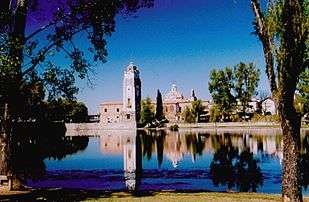Jesuit Block and Estancias of Córdoba
| Jesuit Block and Estancias of Córdoba | |
|---|---|
| Name as inscribed on the World Heritage List | |
 | |
| Type | Cultural |
| Criteria | ii, iv |
| Reference | 995 |
| UNESCO region | Latin America and the Caribbean |
| Inscription history | |
| Inscription | 2000 (24th Session) |
The Jesuit Block and Estancias of Córdoba (Spanish: Manzana Jesuítica y Estancias de Córdoba) are a former Jesuit reduction built by missionaries in the province of Córdoba, Argentina, named a World Heritage Site in 2000.
The Manzana Jesuítica contains the University of Córdoba, one of the oldest in South America, the Monserrat Secondary School, a church, and residence buildings. To maintain such a project, the Jesuits operated six Estancias (residences) around the province of Córdoba, named Caroya, Jesús María, Santa Catalina, Alta Gracia, Candelaria and San Ignacio.
The farm and the complex, started in 1615, had to be left by the Jesuits, following the 1767 decree by King Charles III of Spain that expelled them from the continent. They were then run by the Franciscans until 1853, when the Jesuits returned to The Americas. Nevertheless, the university and the high-school were nationalized a year later.
Each Estancia has its own church and set of buildings, around which towns grew, such as Alta Gracia, the closest to the Block. The Estancia San Ignacio no longer exists. The Jesuit Block and the Estancias can be visited by tourists; the Road of the Jesuit Estancias has around 250 kilometres of length.
Jorge Mario Bergoglio, who would later become pope Francis lived there.
External links
- Jesuit Block and Estancias of Córdoba - Argentine Tourism Office
- World Heritage at UNESCO
- Information on the Block and each Estancia
- Estancias Jesuíticas (Spanish)
- Images of the Estancias - Government of Córdoba (Spanish)
- Jesuitic institutions in Argentina
Coordinates: 31°39′22″S 64°26′07″W / 31.65611°S 64.43528°W